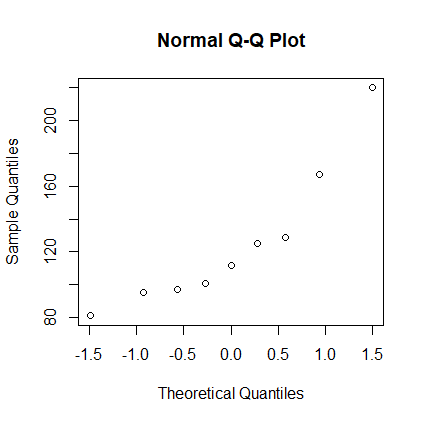Answer: Choose the z-scores that divide the standard normal curve into 9 + 1 = 10 equal areas:
-1.28 -0.84 -0.52 -0.25 0.00 0.25 0.52 0.84 1.28
81 95 97 101 112 125 129 167 220
> x <- c(81, 95, 97, 101, 112, 125, 129, 167, 220) > qqnorm(x)

> # 1a. > pnorm(1) - pnorm(-1) [1] 0.6826895 > # 1b. > pnorm(2) - pnorm(-2) [1] 0.9544997 > # 2. > 1 - pnorm(120, mean=100, sd=15) [1] 0.09121122 > # 3 > (1 - pnorm(175, mean=100, sd=15)) * 10**9 [1] 286.6516
x <- c(54, 89, 23, 56, 80, 45, 76) z <- (x - mean(x)) / sd(x) [1] -0.2809356 1.2486026 -1.6356694 -0.1935334 [4] 0.8552928 -0.6742454 0.6804884
> hist(z)
> x <- c(81, 95, 97, 101, 112, 125, 129, 167, 220) > qqnorm(x)

> x <- rnorm(50, mean=15, sd=3.8) > hist(x) > qqnorm(x)
> x <- runif(50, min=10, max=50)
> x <- runif(50, min=10, max=50) > hist(x) > qqnorm(x)